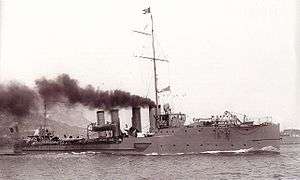French destroyer Boutefeu
 Sister ship Bouclier underway | |
| History | |
|---|---|
| Name: | Boutefeu |
| Namesake: | Linstock |
| Builder: | Dyle et Bacalan, Bordeaux |
| Laid down: | 1909 |
| Launched: | 2 May 1911 |
| Completed: | 1911 |
| Fate: | Sunk by a mine, 15 May 1917 |
| General characteristics | |
| Class and type: | Bouclier-class destroyer |
| Displacement: | 732–809 t (720–796 long tons) |
| Length: | 72.3–78.3 m (237 ft 2 in–256 ft 11 in) (o/a) |
| Beam: | 7.6–8 m (24 ft 11 in–26 ft 3 in) |
| Draft: | 2.9–3.3 m (9 ft 6 in–10 ft 10 in) |
| Installed power: |
|
| Propulsion: | 2 shafts; 2 Zoelly steam turbines |
| Speed: | 30 knots (56 km/h; 35 mph) |
| Range: | 1,200–1,600 nmi (2,200–3,000 km; 1,400–1,800 mi) at 12–14 knots (22–26 km/h; 14–16 mph) |
| Complement: | 80–83 |
| Armament: |
|
Boutefeu was one of a dozen Bouclier-class destroyers built for the French Navy in the first decade of the 20th century. During the First World War she was stationed at Brindisi in support of the Otranto barrage.
On 15 May 1917, during the Battle of the Strait of Otranto, Boutefeu struck a mine laid earlier that day by the Imperial German Navy submarine UC-25 just outside Brindisi harbor. The destroyer broke in two and sank in under two minutes, with heavy loss of life.[1][2]
References
- ↑ World War I: Encyclopedia, Volume 1, p.870; Spencer Tucker, Priscilla Mary Roberts, Paul G. Halpern; ABC-CLIO, 2005
- ↑ World War 1 at Sea-French Navy, Part 2 of 2-Destroyers, Submarines; Gordon Smith, Naval-History.Net http://www.naval-history.net/WW1NavyFrench2.htm retvd 6 27 16
Bibliography
- Couhat, Jean Labayle (1974). French Warships of World War I. London: Ian Allen. ISBN 0-7110-0445-5.
- Gardiner, Robert & Gray, Randal (1985). Conway's All The World's Fighting Ships 1906–1921. London: Conway Maritime Press. ISBN 0-85177-245-5.
This article is issued from Wikipedia - version of the 11/22/2016. The text is available under the Creative Commons Attribution/Share Alike but additional terms may apply for the media files.